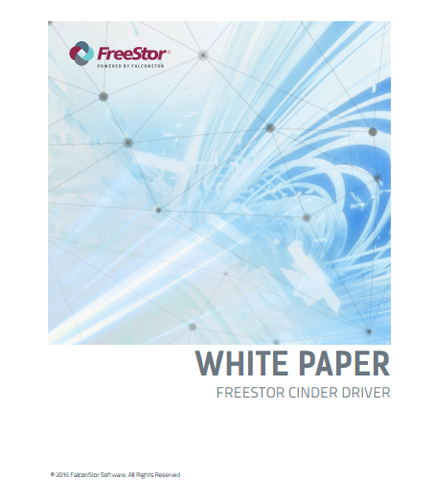
PROCESSING. PLEASE WAIT...

White Paper: FalconStor
Cinder is a Block Storage service for OpenStack. It’s designed to present storage resources to end users that can be consumed by the OpenStack Compute Project (Nova). Cinder is used to centrally manage a service that provisions storage in the form of block devices knows as Cinder volumes.
When the Cinder driver is installed in an OpenStack environment, volumes created on the OpenStack Horizon dashboard with volume type FSS will automatically show as Vdev’s on the GUI.
Three basic services and a dedicated underlying database of Cinder
Potential use cases of persistent block storage In OpenStack
The market adoption of Cinder
Openstack Cinder integration

By: Storage Made Easy
OpenStack Swift is becoming the foremost deployed Private Cloud Storage solution in the world. But OpenStack can end up storing a lot of structured documents such as Word, Powerpoint, Excel, and PDF files. An enterprise grade EFSS solution can help fix complexities by providing audit, security, encryption, back-up and migration capabilities to the files shared in your organization. Read this whitepaper to know how you can get the below mentioned benefits by integrating OpenStack with a comprehensive Enterprise File Synchronization and Sharing (EFSS) solution. Search the contents of files stored on OpenStack. Unify OpenStack files and private data in a single interface for anywhere access. Easily annotate against PDF documents stored on OpenStack. Collaborative round trip creation and editing on documents stored on OpenStack. CloudEdit functionality to edit Documents directly on a user's desktop and save any changes back to OpenStack Swift. Create new or enhance existing dedicated OpenStack applications.
By: FalconStor
Having a business continuity disaster recovery (BCDR) plan is critical to an organization’s success and it is up to you to choose the best DR solution to meet your business needs. Creating a good recovery plan begins with defining recovery objectives and aligning the BCDR strategy with business requirements. A good BCDR plan identifies your recovery objectives and then aligns your strategy to your business requirements. This white paper discusses some disaster recovery (DR) strategies and challenges that an organization might face while creating a business continuity and disaster recovery plan. Elements of a good DR plan Strategies the customers can use to meet ROI recovery requirements Two types of recovery: manual on-premise and automated Recovery in the Cloud with Amazon Web Services (AWS)


 2025 All Rights Reserved | by: www.ciowhitepapersreview.com
2025 All Rights Reserved | by: www.ciowhitepapersreview.com